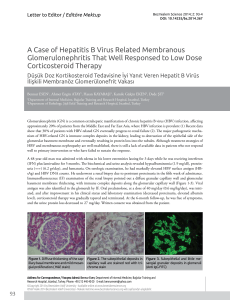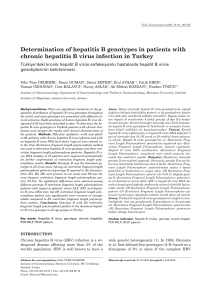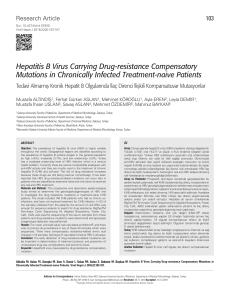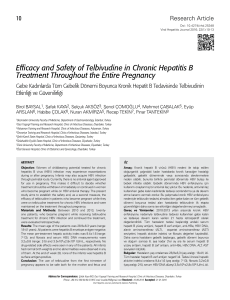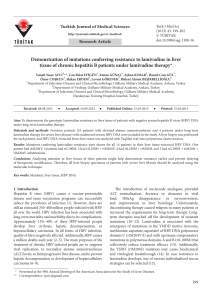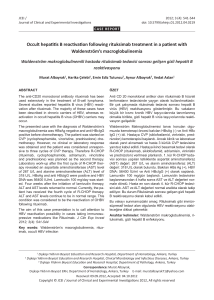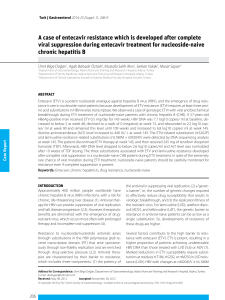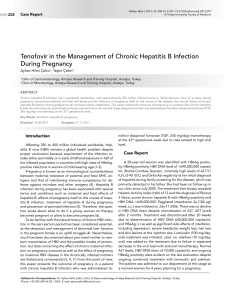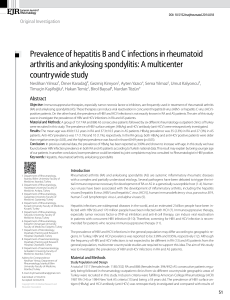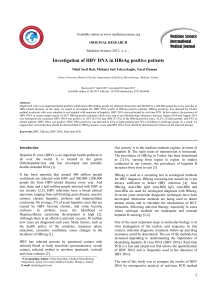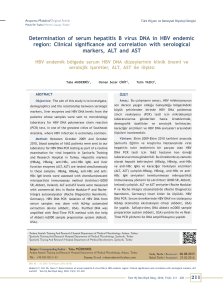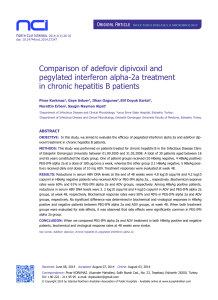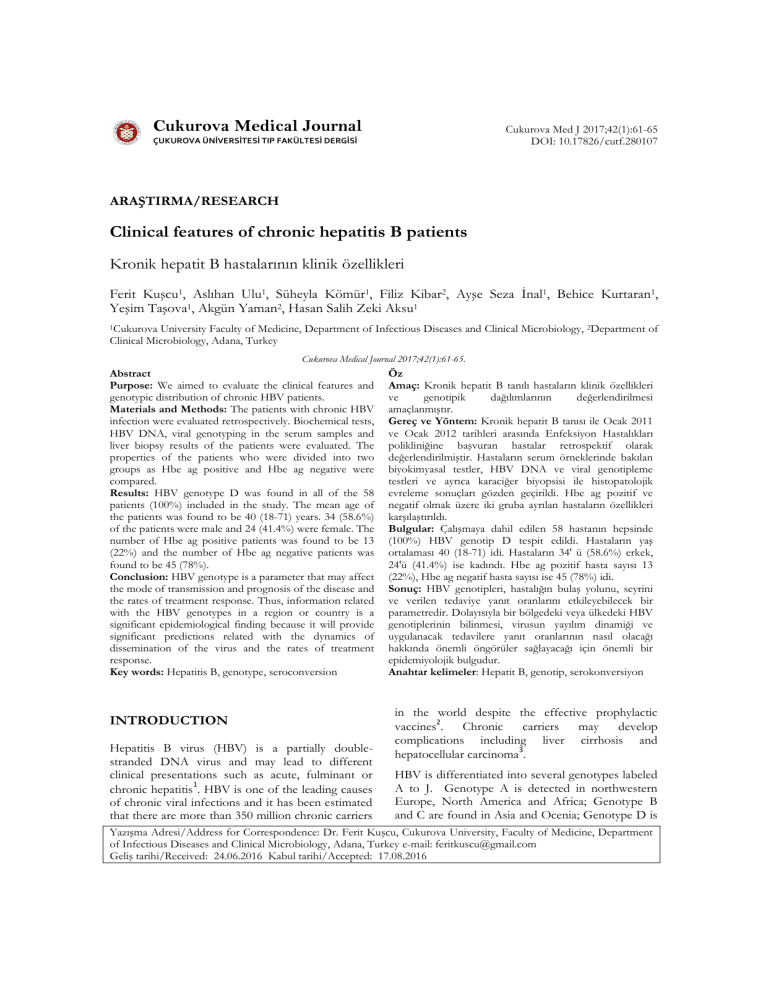
Cukurova Medical Journal
Cukurova Med J 2017;42(1):61-65
DOI: 10.17826/cutf.280107
ÇUKUROVA ÜNİVERSİTESİ TIP FAKÜLTESİ DERGİSİ
ARAŞTIRMA/RESEARCH
Clinical features of chronic hepatitis B patients
Kronik hepatit B hastalarının klinik özellikleri
Ferit Kuşcu1, Aslıhan Ulu1, Süheyla Kömür1, Filiz Kibar2, Ayşe Seza İnal1, Behice Kurtaran1,
Yeşim Taşova1, Akgün Yaman2, Hasan Salih Zeki Aksu1
1Cukurova
University Faculty of Medicine, Department of Infectious Diseases and Clinical Microbiology, 2Department of
Clinical Microbiology, Adana, Turkey
Cukurova Medical Journal 2017;42(1):61-65.
Abstract
Purpose: We aimed to evaluate the clinical features and
genotypic distribution of chronic HBV patients.
Materials and Methods: The patients with chronic HBV
infection were evaluated retrospectively. Biochemical tests,
HBV DNA, viral genotyping in the serum samples and
liver biopsy results of the patients were evaluated. The
properties of the patients who were divided into two
groups as Hbe ag positive and Hbe ag negative were
compared.
Results: HBV genotype D was found in all of the 58
patients (100%) included in the study. The mean age of
the patients was found to be 40 (18-71) years. 34 (58.6%)
of the patients were male and 24 (41.4%) were female. The
number of Hbe ag positive patients was found to be 13
(22%) and the number of Hbe ag negative patients was
found to be 45 (78%).
Conclusion: HBV genotype is a parameter that may affect
the mode of transmission and prognosis of the disease and
the rates of treatment response. Thus, information related
with the HBV genotypes in a region or country is a
significant epidemiological finding because it will provide
significant predictions related with the dynamics of
dissemination of the virus and the rates of treatment
response.
Key words: Hepatitis B, genotype, seroconversion
INTRODUCTION
Hepatitis B virus (HBV) is a partially doublestranded DNA virus and may lead to different
clinical presentations such as acute, fulminant or
1
chronic hepatitis . HBV is one of the leading causes
of chronic viral infections and it has been estimated
that there are more than 350 million chronic carriers
Öz
Amaç: Kronik hepatit B tanılı hastaların klinik özellikleri
ve
genotipik
dağılımlarının
değerlendirilmesi
amaçlanmıştır.
Gereç ve Yöntem: Kronik hepatit B tanısı ile Ocak 2011
ve Ocak 2012 tarihleri arasında Enfeksiyon Hastalıkları
polikliniğine başvuran hastalar retrospektif olarak
değerlendirilmiştir. Hastaların serum örneklerinde bakılan
biyokimyasal testler, HBV DNA ve viral genotipleme
testleri ve ayrıca karaciğer biyopsisi ile histopatolojik
evreleme sonuçları gözden geçirildi. Hbe ag pozitif ve
negatif olmak üzere iki gruba ayrılan hastaların özellikleri
karşılaştırıldı.
Bulgular: Çalışmaya dahil edilen 58 hastanın hepsinde
(100%) HBV genotip D tespit edildi. Hastaların yaş
ortalaması 40 (18-71) idi. Hastaların 34' ü (58.6%) erkek,
24'ü (41.4%) ise kadındı. Hbe ag pozitif hasta sayısı 13
(22%), Hbe ag negatif hasta sayısı ise 45 (78%) idi.
Sonuç: HBV genotipleri, hastalığın bulaş yolunu, seyrini
ve verilen tedaviye yanıt oranlarını etkileyebilecek bir
parametredir. Dolayısıyla bir bölgedeki veya ülkedeki HBV
genotiplerinin bilinmesi, virusun yayılım dinamiği ve
uygulanacak tedavilere yanıt oranlarının nasıl olacağı
hakkında önemli öngörüler sağlayacağı için önemli bir
epidemiyolojik bulgudur.
Anahtar kelimeler: Hepatit B, genotip, serokonversiyon
in the world despite the effective prophylactic
2
vaccines .
Chronic
carriers
may
develop
complications including liver cirrhosis and
3
hepatocellular carcinoma .
HBV is differentiated into several genotypes labeled
A to J. Genotype A is detected in northwestern
Europe, North America and Africa; Genotype B
and C are found in Asia and Ocenia; Genotype D is
Yazışma Adresi/Address for Correspondence: Dr. Ferit Kuşcu, Cukurova University, Faculty of Medicine, Department
of Infectious Diseases and Clinical Microbiology, Adana, Turkey e-mail: [email protected]
Geliş tarihi/Received: 24.06.2016 Kabul tarihi/Accepted: 17.08.2016
Cilt/Volume 42 Yıl/Year 2017
Clinical features of chronic HBV
more common in the Mediterranean countries, the
Middle East, and India; Genotype E is found in
West Coast of Africa. Genotypic diversity of the
HBV can affect the disease progression and
3-5
response to interferon based therapy .
Mannheim, Germany). The purified DNA was
amplified over two rounds of PCR by using
biotinylated PCR primers. A part (domain B and C)
of the HBV polymerase gene was amplified (first
round). A nested PCR
(second round) was
performed by amplified product of the first round
PCR. After amplification, biotinylated DNA
material generated from the HBs Ag open reading
frame was hybridized with specific oligonucleotide
probes immobilized as parallel lines on membranebased strips. Unhybridized DNA was washed from
the strip and then, streptavidin labeled with alkaline
phosphatase was added and bound to biotinylated
hybrid.
Addition of BCIP/NBT cromogenic
substrate (5-bromo-4-chloro-3-indolylphosphate/4nitro-blue tetrazolium in dimethylformamide)
resulted in a purple/brown precipitate line. A line is
considered positive when a clear purple/brown
band appears at the end of the test procedure. The
INNO-LiPA HBV Genotyping strip contains one
red marker line, 2 control lines and 14 parallel probe
lines. The conjugate control line is a control for the
color development reaction and the amplification
control line contains universal HBV probes to check
the presence of amplified HBV genomic material.
HBV genotypes were determined using the kit
interpretation chart.
In this study we aimed to evaluate the clinical
features and genotypic distribution in chronic HBV
patients in southern Turkey.
MATERIALS AND METHODS
Patients
The patients admitted to the Infectious Diseases
outpatient clinic with chronic HBV infection
between October 2010 and May 2011 were
evaluated retrospectively. The patients who had Hbs
ag positivity for longer than 6 months were
considered to have chronic HBV infection.
Antiviral treatment was started in patients with
chronic hepatitis B in accordance with the Turkish
public health system.
Hbs Ag, Hbe Ag and Anti Hbe states were specified
by ‘’Microparticle Enzyme Immunassay’’ (Abbott
ARCHITECT
i2000).
Serum
alanine
aminotransferase (ALT) and aspartate transaminase
(AST) values were measured by routine automated
systems and a value of 40 IU/L was considered the
upper limit. The liver biopsy samples obtained from
the patients were evaluated by the pathology
division of our hospital with Knodell classification
according to histological activity indexes and fibrosis
stages.
Statistical Analysis
Statistical analysis was performed using the SPSS
v20.0 package program. In descriptive statistics, the
continuous variables were expressed as mean and
standard deviation and the discrete variables were
expressed as median and range. Comparison
between categorical variables was performed using
Fisher’s exact test and comparison between
continuous variables was performed using t-test or
Mann-Whitney U test. A p value of <0,05 was
considered statistically significant.
HBV DNA extraction, quantification and
genotyping
HBV DNA detection and quantification was made
using The COBAS®
ampliPrep/COBAS®
TaqMan® HBV Test, version 2.0 Real Time PCR
assay (Roche Molecular Systems). Genotyping of
Hepatitis B virus was performed by using the
INNO-LiPA HBV genotyping kit (Innogenetics,
Belgium), according to the manufacturer's
instructions. The test is a line probe assay designed
to identify HBV genotypes (A,B,C,D,E,F,G,H) by
the detection of type-specific sequences in the HBV
polymerase gene domain B to C. This is a reverse
hybridization method. In the first step, HBV DNA
was extracted using Total Nucleic Acid Isolation Kit
on the MagNA Pure LC 2.0 instrument (Roche
Diagnostics GmbH, Roche Applied Science,
RESULTS
The mean age of 58 patients included in the study
was 40 (18-71) years. 34 (58.6%) of the patients
were male and 24 (41.4%) were female. The mean
AST and ALT values were found to be 39.4±28.6
U/L and 63.8±62.0 U/L. The median value of HBV
DNA log10 was found to be 5.12 (2.40-8.23). Liver
biopsy was performed in 54 of the patients and the
median Knodell score and Fibrosis values were
found to be 6 (2-16) and 2 (0-6), respectively.
62
Cukurova Medical Journal
Kuşcu et al.
A diagnosis of hepatic cirrhosis was made
histopathologically in only one of the patients. The
number of Hbe ag positive patients was found to be
13 (22%) and the number of Hbe ag negative
patients was found to be 45 (78%). When the
patients were divided into two groups as Hbe ag
positive and negative patients, no statistically
significant difference was found between the groups
in terms of gender and Fibrosis and Knodell scores.
The mean age was statistically significantly lower
and AST, ALT and HBV DNA levels were higher in
Hbe Ag positive patients (Table 1). The inital drugs
used in 37 patients who met treatment initiation
criteria and secondary drugs given to 10 of these
patients in whom drug treatment was changed
because of unresponsiveness are shown in Table 2.
Drug treatment was changed in one of the Hbe Ag
positive patients and in 9 of the Hbe Ag negative
patients. No statistically significant difference was
found between the groups in terms of drug
treatment change. Drug treatment was changed in
all three patients (100%) in whom pegylated
interferon was initiated, in 6 (67%) of 9 patients in
whom lamivudine was initiated and in 1 (100%)
patient in whom adefovir was initiated. The patients
in whom telbivudin, entecavir and tenofovir were
initiated did not need any change in drug treatment.
HBs ag loss did not occur in any patient and Anti
Hbe seroconversion did not develop in any of the
Hbe ag positive patients. Genotype D was found in
all samples obtained from 58 patients.
Table 1.Characteristics of the Hbe ag positive and negative patients
Characteristic
Age (mean±SD)
Gender (Male/Female)
ALT, U/L(mean±SD)
AST, U/L (mean±SD)
HBV DNA log10, IU/mL
(median, range)
Knodell Score (median,
range)
Fibrosis (median, range)
Number of patients who
needed change in drug
treatment (%)
Hbe Ag positive (n=13)
p value
27±8
10/3
90.2±77.3
51.4±41.0
8,23 (6.82-8.23)
Hbe Ag negative
(n=45)
43±12
24/21
56.2±55.5
35.9±23.4
4.57 (2.40-8.23)
7 (4-12)
6 (2-16)
0.479
2 (1-3)
1 (8%)
2 (0-6)
9 (20%)
0.846
0.08
0.0001
0.128
0.006
0.031
0.0001
Table 2. Initial antiviral treatments and switched second-line drugs due to unresponsiveness.
Initial Therapy (n=37)
Pegylated interferon α-2a (n=3)
Switched Therapy (n=10)
Lamivudin (n=1)
Telbivudin (n=1)
Tenofovir (n=1)
Tenofovir (n=5)
Entekavir (n=1)
Tenofovir (n=1)
-
Lamivudin (n=9)
Adefovir (n=1)
Telbivudin (n=5)
Entecavir (n=7)
Tenofovir (n=12)
level of the host, age, gender, ethnic origin,
comorbidity, socioeconomical level and HBV
genotype determine the natural course of HBV
infection7, 8.
DISCUSSION
Individuals with chronic HBV infection go through
different phases including immunotolerant,
immunoclearance, inactive, reactivation and immune
control phases. Many factors including viral
replication and mutations, the immune response
In a portion of patients with chronic HBV
infections who develop HbeAg seroconversion,
normal serum ALT levels, HbeAg loss and anti
63
Cilt/Volume 42 Yıl/Year 2017
Clinical features of chronic HBV
HbeAb development and undetectable HBV DNA
levels (inactive phase) are achieved. In some
patients, HBV replication continues despite a
negative Hbe Ag and increased ALT levels and
moderate or advanced changes in hepatic histology
are found (reactivation phase) as a result of
mutations developing in the precore or basal core
promoter regions of the virus8, 9. Precore and basal
core promoter mutations are frequently observed in
HBV genotype D variants and cause to Hbe ag
negative chronic HBV infection8. In our study, the
reason that the rate of Hbe Ag negative patients was
found to be high (78%) was the fact that all our
patients were infected with HBV genotype D. In
different studies conducted in our country, it was
reported that the predominant genotype is genotype
D. In the study conducted by Atalay et al., genotype
D was found in 107 (97.2%) of 110 patients and
genotyping was not performed in 3 patients; the rate
of Hbe ag negative patients was found to be 82%
similar to our study10. In another multi-center study
in which the genotype distribution of acute hepatitis
B patients was investigated, genotype D was found
in 147 of 158 patients and typing could not be made
in 11 patients11. Similarly, the predominant genotype
was shown to be genotype D in all studies
conducted in different regions of Turkey12-14.
advantageous compared to the other molecules. In
chronic HBV patients treated with lamivudine,
resistance is observed with a rate of about 20% at
the end of one year and with a rate of about 70% at
the end of five years19. In our study, change in drug
treatment was needed with a very high rate (67%) in
the patients in whom lamivudine treatment was
initiated because of an increase in viral load. An
efficient viral suppression was provided in the
patients in whom treatment with tenofovir and
entecavir was initiated and their treatments are being
continued. Lamivudine is not one of the first-line
drug in treatment of HBV infection because of high
resistance rates. Potent antivirals including entecavir
and tenofovir should be the first-line drugs20.
A limitation of our study was the fact that different
HBV genotypes could not be compared in terms of
treatment response or disease progression, because
HBV genotype D was found in all patients included
in the study. In addition, it is thought that there may
be clinical and/or viral differences between the
subgenotypes of HBV genotype D as a result of the
studies conducted21. We could not evaluate our
patients in this regard, because we did not have
HBV subgenotype results.
Studies have shown that the structural and
functional differences between HBV genotypes may
affect the mode of transmission, prognosis, severity
and progression of the disease, potential
complications and the rates of treatment response in
HBV infection22. Hence, information related with
the HBV genotypes in our country is a significant
epidemiological finding, because it will provide
significant predictions related with the dynamics of
dissemination of the virus and the rates of treatment
response23. Although the predominant genotype was
found to be genotype D in all different studies
conducted in Turkey, our specific region harbors a
potential of change in HBV genotypes in time,
because it harbors both refugees of war and
intensive human traffic. Therefore, the distribution
of HBV genotype should be investigated with
certain intervals because it will provide significant
ideas related with the dynamics of the disease.
The final objective in treatment of hepatitis B is Hbs
ag seroconversion, but this outcome is obtained
with a rate of 3% with interferon or pegylated
interferon and with a rate of 1% with oral antivirals
administered for one year15. Hbs ag seroconversion
was not observed in any of our patients. In different
studies, no difference could be found in the rates of
response to nucleotide analogues between HBV
genotypes, whereas HBV genotype D infections had
a lower rate of response to interferon treatment16, 17.
Although the number of patients was low, oral
antivirals had to be initiated because of
unresponsiveness to pegylated interferon treatment
in three of our patients.
It is possible to provide a strong and long-term viral
suppression by preventing viral replication with
nucleoside analogues used in treatment of chronic
HBV treatment. However, the disadvantages of
these antiviral drugs include failure to reach
satisfactory rates in Hbs ag eradication, requirement
for using these drugs for a lifetime and potential of
development of resistance18. Lamivudine is the first
nucleoside analogue approved for HBV treatment.
It is used widely because it is pharmacoeconomically
REFERENCES
1.
2.
3.
64
Seeger C, Mason WS. Hepatitis B virus biology.
Microbiol Mol Biol Rev. 2000;64:51-68.
Liaw YF, Chu CM. Hepatitis B virus infection.
Lancet. 2009;373:582-92.
Trepo C, Chan HL, Lok A. Hepatitis B virus
Cukurova Medical Journal
Kuşcu et al.
4.
5.
6.
7.
8.
9.
10.
11.
12.
13.
14.
.
infection. Lancet. 2014;384:2053-63.
Sunbul M. Hepatitis B virus genotypes: global
distribution and clinical importance. World J
Gastroenterol 2014;20:5427-34.
Lindh M, Andersson AS, Gusdal A. Genotypes, nt
1858 variants, and geographic origin of hepatitis B
virus-largescale analysis using a new genotyping
method. J Infect Dis. 1997;175:1285-1293.
Lok AS, McMahon BJ. AASLD Practice Guideline
Update. Chronic Hepatitis B: Update 2009.
Hepatology. 2009;50:661-662.
Fattovich G, Bortolotti F, Donato F. Natural history
of chronic hepatitis B:special emphasis on disease
progression and prognostic factors. J Hepatol.
2008;48:335-52.
Kim BK, Revill PA, Ahn SH. HBV genotypes:
relevance to natural history, pathogenesis and
treatment of chronic hepatitis B. Antivir Ther.
2011;16:1169-86.
McMahon BJ. Epidemiology and natural history of
hepatitis B. Semin Liver Dis. 2005;25:3-8.
Atalay MA, Gokahmetoglu S, Aygen B. Genotypes
of hepatitis B virus in Central Anatolia, Kayseri,
Turkey. Saudi Med J. 2011;32:3630–33.
Leblebicioglu H, Eroglu C. Acute hepatitis B virus
infection in Turkey: epidemiology and genotype
distribution. Clin Microbiol Infect. 2004;10:537-41.
Ciftci S, Keskin F, Badur S: Clinical features of
hepatitis B virus genotypes in Turkish patients. J Pak
Med Assoc. 2012;62:759-63.
Emekdaş G, Tezcan S, Aslan G, Serin MS, Sezgin O,
Uçbilek E et al.. Determination of hepatitis B virus
genotypes in chronic hepatitis B patients in Mersin
province, Turkey. Mikrobiyol Bul. 2012;46:432-45.
Kaya S, Cetin ES, Aridogan BC, Onal S, Demirci M.
Distribution of hepatitis B virus (HBV) genotypes
15.
16.
17.
18.
19.
20.
21.
22.
23.
65
among HBV carriers in Isparta. Iran Biomed J.
2007;11:59-63.
Moucari R, Korevaar A, Lada O, Martinot-Peignoux
M, Boyer N, Mackiewicz V et al. High rates of
HBsAg seroconversion in HBeAg-positive chronic
hepatitis B patients responding to interferon: a longterm follow-up study. J Hepatol. 2009;50:1084-92.
Wiegand J, Hasenclever D, Tillmann HL. Should
treatment of hepatitis B depend on hepatitis B virus
genotypes? A hypothesis generated from an
explorative analysis of published evidence. Antiviral
Ther. 2008;13:211-20.
Flink HJ, van Zonneveld M, Hansen BE, de Man
RA, Schalm SW, Janssen HL, HBV 99–01 study
group: Treatment with Peg-interferon alpha-2b for
HBeAg-positive chronic hepatitis B: HBsAg loss is
associated with HBV genotype. Am J Gastroenterol.
2006;101:297-303.
Zoulim F. Are novel combination therapies needed
for chronic hepatitis B? Antiviral Res. 2012;96:256–9.
Lok AS, Lai CL, Leung N, Yao GB, Cui ZY, Schiff
ER et al. Long-term safety of lamivudine treatment
in
patients
with
chronic
hepatitis
B.
Gastroenterology. 2003;125:1714-22.
European Association For The Study Of The Liver.
EASL clinical practice guidelines: Management of
chronic hepatitis B virus infection. J Hepatol.
2012;57:167-85.
Ozaras R, Balkan II, Yemisen M, Tabak F.
Epidemiology of HBV subgenotypes D. Clin Res
Hepatol Gastroenterol. 2015;39:28-37.
Kramvis A, Kew M, François G. Hepatitis B virus
genotypes. Vaccine. 2005;23:2409-23.
Allain JP. Epidemiology of Hepatitis B Virus and
Genotype. J Clin Virol. 2006;36:12-7.

